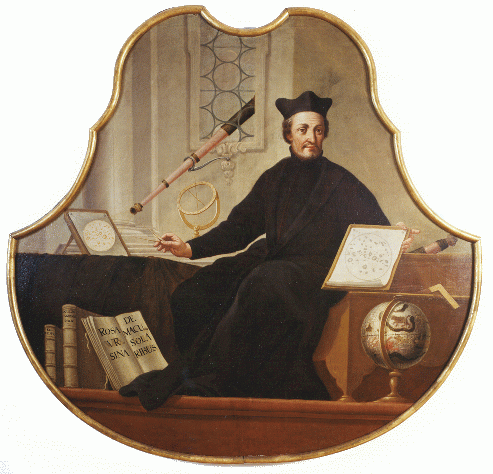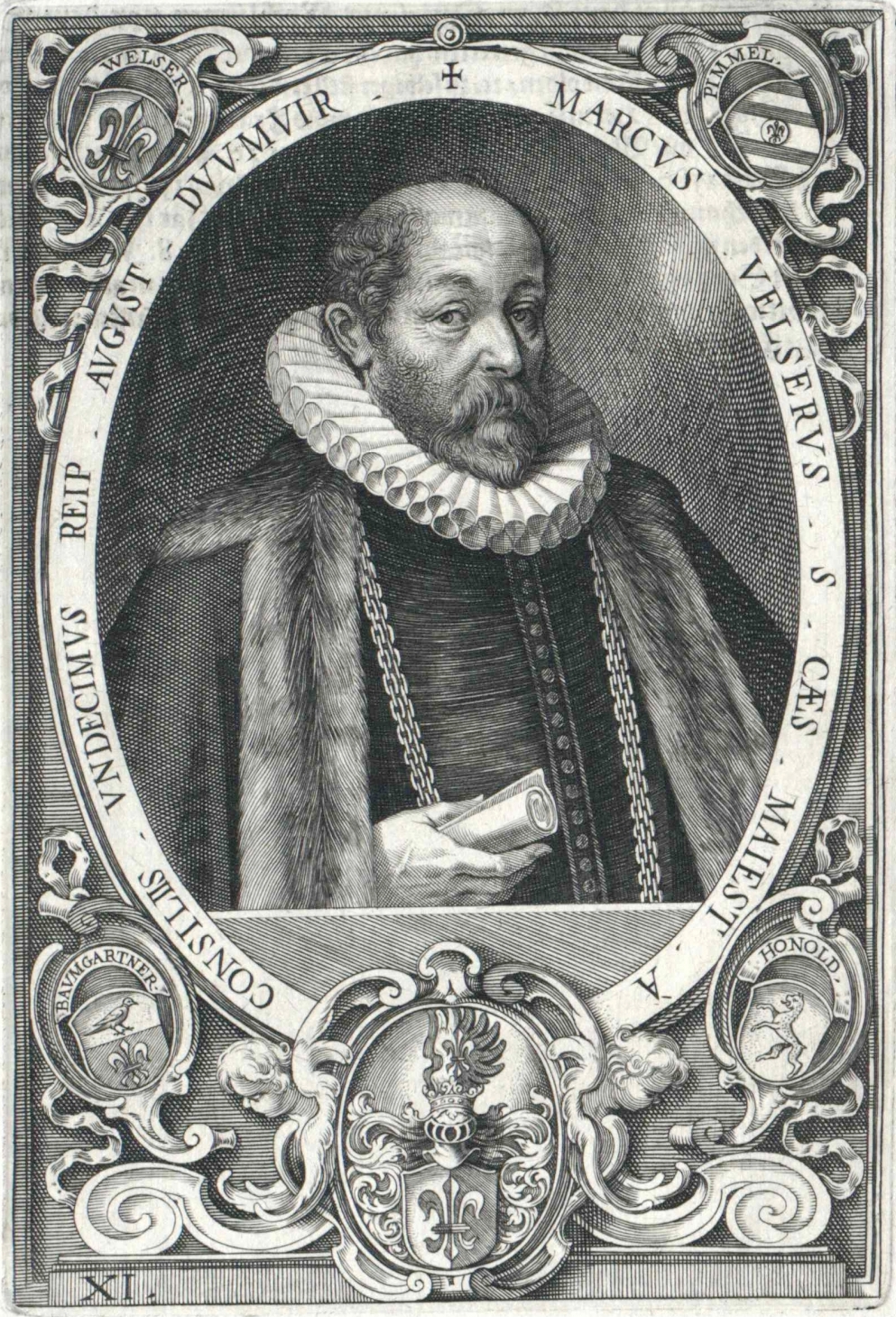|
Christoph Scheiner
Christoph Scheiner SJ (25 July 1573 (or 1575) – 18 June 1650) was a Jesuit priest, physicist and astronomer in Ingolstadt. Biography Augsburg/Dillingen: 1591–1605 Scheiner was born in Markt Wald near Mindelheim in Swabia, earlier markgravate Burgau, possession of the House of Habsburg. He attended the Jesuit St. Salvator Grammar School in Augsburg from May 1591 until 24 October 1595. He graduated as a "rhetor" and entered the Jesuit Order in Landsberg am Lech on 26 October 1595. At the local seminary, he served his biennial novitiate (1595–1597) under the tutelage of Novice Master Father Rupert Reindl SJ. From 1597 to 1598, he finished his lower studies of rhetoric in Augsburg. He took his first vows before Father Melchior Stör, SJ and received the minor orders from the Augsburg suffragan bishop Sebastian Breuning. He spent the years 1598–1601 in Ingolstadt studying philosophy (metaphysics and mathematics). In 1603, Scheiner invented the pantograph, "Lake Cou ... [...More Info...] [...Related Items...] OR: [Wikipedia] [Google] [Baidu] |
Scheiner Christoph
Scheiner is a German surname. Notable people with the surname include: *Artuš Scheiner, Czech painter and illustrator *Christoph Scheiner, Jesuit priest, physicist and astronomer (born c. 1573) *David Scheiner (born 1938), American physician and activist *Elliot Scheiner, record producer and record engineer *Julius Scheiner (1858, Cologne – 1913), German astronomer, astrophysicist and Jesuit *Rabbi Mordechai Scheiner *Rebecca Scheiner, German female stage director *Rabbi Yitzchok Scheiner See also *Scheiner (crater), lunar impact crater that lies to the west of the enormous walled plain Clavius, named after Christoph Scheiner *Shiner (surname) *Schein Schein is the surname of: * Charles Schein (1928–2003), French polymer chemist of Romanian origin * David D. Schein * Edgar Schein (born 1928), professor at the MIT Sloan School of Management * Johann Hermann Schein (1586–1630), German compose ... References {{surname, Scheiner German-language surnames Jewish surnam ... [...More Info...] [...Related Items...] OR: [Wikipedia] [Google] [Baidu] |
Mathematics
Mathematics is an area of knowledge that includes the topics of numbers, formulas and related structures, shapes and the spaces in which they are contained, and quantities and their changes. These topics are represented in modern mathematics with the major subdisciplines of number theory, algebra, geometry, and analysis, respectively. There is no general consensus among mathematicians about a common definition for their academic discipline. Most mathematical activity involves the discovery of properties of abstract objects and the use of pure reason to prove them. These objects consist of either abstractions from nature orin modern mathematicsentities that are stipulated to have certain properties, called axioms. A ''proof'' consists of a succession of applications of deductive rules to already established results. These results include previously proved theorems, axioms, andin case of abstraction from naturesome basic properties that are considered true starting points of ... [...More Info...] [...Related Items...] OR: [Wikipedia] [Google] [Baidu] |
Maximilian III, Archduke Of Austria
Maximilian III of Austria, briefly known as Maximilian of Poland during his claim for the throne (12 October 1558 – 2 November 1618), was the Archduke of Further Austria from 1612 until his death. Biography Born in Wiener Neustadt, Maximilian was the fourth son of the emperor Maximilian II and Maria of Spain. He was a grandson of Anna of Bohemia and Hungary, daughter and heiress of Vladislaus II of Bohemia and Hungary, who himself was the eldest son of Casimir IV of Poland from the Jagiellonian Dynasty. From 1585 Maximilian became the Grandmaster of the Teutonic Order; thanks to this he was known by the epithet ''der Deutschmeister'' ("the German Master")In fact, originally the titles ''Hochmeister'' ("Grandmaster") and ''Deutschmeister'' ("German Master") were different: while Grandmaster was the highest order dignitary, the German Master was the third highest and territorially restricted to area of the Holy Roman Empire (apart from Prussia and Livonia) where he administered ... [...More Info...] [...Related Items...] OR: [Wikipedia] [Google] [Baidu] |
Innsbruck, Austria
Innsbruck (; bar, Innschbruck, label=Austro-Bavarian ) is the capital of Tyrol and the fifth-largest city in Austria. On the River Inn, at its junction with the Wipp Valley, which provides access to the Brenner Pass to the south, it had a population of 132,493 in 2018. In the broad valley between high mountains, the so-called North Chain in the Karwendel Alps (Hafelekarspitze, ) to the north and Patscherkofel () and Serles () to the south, Innsbruck is an internationally renowned winter sports centre; it hosted the 1964 and 1976 Winter Olympics as well as the 1984 and 1988 Winter Paralympics. It also hosted the first Winter Youth Olympics in 2012. The name means "bridge over the Inn". History Antiquity The earliest traces suggest initial inhabitation in the early Stone Age. Surviving pre-Roman place names show that the area has been populated continuously. In the 4th century the Romans established the army station Veldidena (the name survives in today's urban district Wilt ... [...More Info...] [...Related Items...] OR: [Wikipedia] [Google] [Baidu] |
Mutio Vitelleschi
Mutio Vitelleschi (2 December 1563 – 9 February 1645) was the sixth Superior General of the Society of Jesus. He was the son of a noble Roman family. Although he was destined for a general ecclesiastical career, a growing desire to enter the Society of Jesus culminated in his taking private vows to enter the novitiate. His parents opposed this, possibly because of the promise not to seek ecclesiastical office or status that Jesuits make. However he was able to receive permission from Pope Gregory XIII, a strong supporter of the Jesuits, a concession to enter the novitiate against his family's will. Work Vitelleschi taught logic in 1588–1589, natural philosophy in 1589–1590, and metaphysics in 1590–15891; later he was professor of theology, then prefect of studies and finally he was elected general of the Society of Jesus in 1615. His lectures on natural philosophy include ''Physics'', ''De caelo'', ''De generatione'', and ''Meteorology''. Early missions in the So ... [...More Info...] [...Related Items...] OR: [Wikipedia] [Google] [Baidu] |
Exegesis
Exegesis ( ; from the Ancient Greek, Greek , from , "to lead out") is a critical explanation or interpretation (logic), interpretation of a text. The term is traditionally applied to the interpretation of Bible, Biblical works. In modern usage, exegesis can involve critical interpretations of virtually any text, including not just religious texts but also philosophy, literature, or virtually any other genre of writing. The phrase ''Biblical exegesis'' can be used to distinguish studies of the Bible from other critical textual explanations. Textual criticism investigates the history and origins of the text, but exegesis may include the study of the historical and cultural backgrounds of the author, text, and original audience. Other analyses include classification of the type of literary genres presented in the text and analysis of grammar, grammatical and syntax, syntactical features in the text itself. Usage One who practices exegesis is called an ''exegete'' (; from the Greek ... [...More Info...] [...Related Items...] OR: [Wikipedia] [Google] [Baidu] |
Georg Schönberger
Georg may refer to: * Georg (film), ''Georg'' (film), 1997 *Georg (musical), Estonian musical * Georg (given name) * Georg (surname) * , a Kriegsmarine coastal tanker See also * George (other) {{disambiguation ... [...More Info...] [...Related Items...] OR: [Wikipedia] [Google] [Baidu] |
Letters On Sunspots
'' Letters on Sunspots '' (''Istoria e Dimostrazioni intorno alle Macchie Solari'') was a pamphlet written by Galileo Galilei in 1612 and published in Rome by the Accademia dei Lincei in 1613. In it, Galileo outlined his recent observation of dark spots on the face of the Sun. His claims were significant in undermining the traditional Aristotelian view that the Sun was both unflawed and unmoving. ''The Letters on Sunspots'' was a continuation of ''Sidereus Nuncius,'' Galileo's first work where he publicly declared that he believed that the Copernican system was correct. Previous observations of sunspots Galileo was not the first person to observe sunspots. The earliest apparent reference to them appears in the I Ching of ancient China, while the earliest recorded observation is also Chinese, dating to 364 BC. Around the same time, the first European mention of sunspots is found, by Theophrastus. There were reports from IslamicJ.M. Vaquero, M. Vázquez, The Sun Recorded Throu ... [...More Info...] [...Related Items...] OR: [Wikipedia] [Google] [Baidu] |
Galileo Galilei
Galileo di Vincenzo Bonaiuti de' Galilei (15 February 1564 – 8 January 1642) was an Italian astronomer, physicist and engineer, sometimes described as a polymath. Commonly referred to as Galileo, his name was pronounced (, ). He was born in the city of Pisa, then part of the Duchy of Florence. Galileo has been called the "father" of observational astronomy, modern physics, the scientific method, and modern science. Galileo studied speed and velocity, gravity and free fall, the principle of relativity, inertia, projectile motion and also worked in applied science and technology, describing the properties of pendulums and "hydrostatic balances". He invented the thermoscope and various military compasses, and used the telescope for scientific observations of celestial objects. His contributions to observational astronomy include telescopic confirmation of the phases of Venus, observation of the four largest satellites of Jupiter, observation of Saturn's rings, and a ... [...More Info...] [...Related Items...] OR: [Wikipedia] [Google] [Baidu] |
Mark Welser
Mark Welser (1558–1614) was a German banker, politician, and astronomer, who engaged in learned correspondence with European intellectuals of his time. Of particular note is his exchange with Galileo Galilei, regarding sunspots. Biography Welser belonged to a rich family of the old German nobility that had emerged in the city of Augsburg. His uncle Bartholomeus Welser was one of the originators of the family wealth; with the Fugger family he financed the imperial election of Charles V, whose counselor he became. He was a commercial leader in Portuguese spices and in the economic growth of Antwerp. He also had an economic relationship with the French crown. In 1528, Bartholomeus, who had outfitted a fleet to the Americas, took control of the colony of Venezuela, obtaining from the emperor the right to retain ownership of it via an annual payment. His descendants kept it until 1555, when Spain took control of Venezuela. At the age of 16, Mark was sent to Padua, where he ... [...More Info...] [...Related Items...] OR: [Wikipedia] [Google] [Baidu] |
Apelles
Apelles of Kos (; grc-gre, Ἀπελλῆς; fl. 4th century BC) was a renowned painter of ancient Greece. Pliny the Elder, to whom much of modern scholars' knowledge of this artist is owed (''Naturalis Historia'' 35.36.79–97 and ''passim''), rated him superior to preceding and subsequent artists. He dated Apelles to the 112th Olympiad (332–329 BC), possibly because he had produced a portrait of Alexander the Great. Biography Probably born at Colophon in Ionia, he first studied under Ephorus of Ephesus, but after he had attained some celebrity he became a student to Pamphilus at Sicyon He thus combined the Dorian thoroughness with the Ionic grace. Attracted to the court of Philip II, he painted him and the young Alexander with such success that he became the recognized court painter of Macedon, and his picture of Alexander holding a thunderbolt ranked in the minds of many with the Alexander with the spear of the sculptor Lysippus. Hundreds of years later, Plutar ... [...More Info...] [...Related Items...] OR: [Wikipedia] [Google] [Baidu] |







